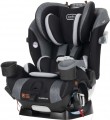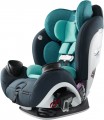Installation
—
Seat belt. Installation with the car seat belt. In weight groups 0, 0+ and 1, only the seat is secured in this way; the child's safety is ensured by the seat's own belts. In weight groups 2 and 3, the car belt is used to secure both the seat and the child.
—
Tor Tether. An additional harness to increase the security of fixation used in seats with Isofix and Latch systems (see below). One end of the harness is attached to the upper part of the backrest and the other end is attached to a special bracket installed in the floor of the car behind the seat or in the trunk. This reduces the likelihood of the seat being knocked over in a sudden braking or frontal impact and increases the overall safety of the small passenger.
—
Support leg. An additional attachment in the form of a support running from the bottom of the seat to the floor of the car. The purpose is similar to the Top Tether described above: it increases the safety of the seat and reduces the risk of the seat toppling when the car comes to a sudden stop. It is most often used with the Isofix system.
—
ISOFIX. The installation system for car seats in the weight category up to 18 kg is primarily found in cars from European manufacturers. The seat is secured with two locks in the rear lower part, with optional additional attachments at the top and/or b
...ottom. The design ensures foolproof installation, making it nearly impossible to install the seat incorrectly. Isofix requires the car to be equipped with suitable brackets, but even without them, these seats can usually be securely installed using the regular seat belt. However, this option may not be cost-effective, as seats with the Isofix system tend to be relatively expensive.
— LATCH. Installation system similar to Isofix. It is used mainly in American cars and, accordingly, in car seats of American manufacturers. The seat is attached at three points — two at the bottom of the seat and one at the top — so that the seat cannot be installed incorrectly. Like Isofix, seats with Latch also allow fixation with the normal car seat belt.Installation
—
Forward facing. Installing the car seat facing in the direction of the car. In this way, car seats of weight groups starting from 1 and above are installed.
—
Rear facing. Install the seat facing against the direction of travel of the car. This is how seats of weight groups 0 and 0+ designed for very young babies are installed. These babies have cervical muscles not yet sufficiently developed to hold their head in a more or less severe frontal impact, so when the seat is positioned in the direction of travel, such an impact can lead to damage to the cervical spine, up to fatal. The backrest of the seat prevents critical displacement of the head when positioned against the driving direction.
—
Sideways. An option used in some models for very young babies. These car seats are usually elongated carrycots that are difficult to fit into the car in any other way. Some models have a swivel/folding carrycot design, which allows to turn it into a car seat and turn it to be faced against the movement or in the direction of travel; nevertheless, in the form of a carrycot, such devices are still placed sideways, hence the name. Note that from a safety point of view, this option is generally less preferable than a rear-facing position, but such designs perform well in side impacts.
Additional side protection
The car seat has structural elements that further protect the child from side impacts. At least such elements include sidewalls for head protection made of impact-absorbing material such as polyurethane foam; torso protection may also be provided. If you are looking for a car seat with the maximum level of protection, you should choose from models with
additional side protection.

